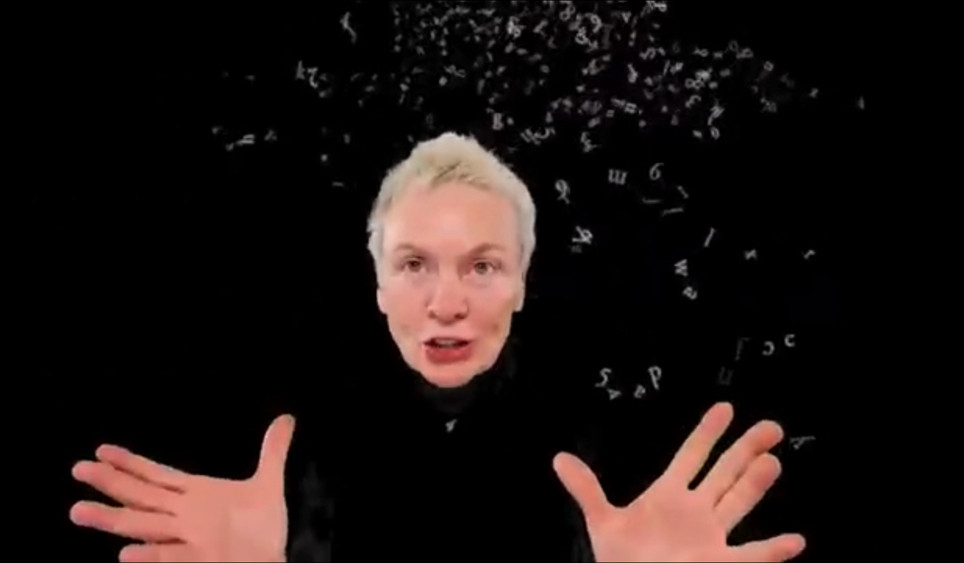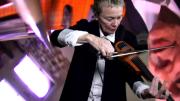For decades, Laurie Anderson dreamed of having a late-night radio show. She wanted to reach people during that period of time when “most of the listeners are half-asleep or trying to get back to sleep, a time when reality and dreams just sort of merge and it’s hard to tell the difference between them.” Anderson’s Norton Lectures achieve a similar effect to the 4 a.m. radio show, though they air in the middle of the afternoon. The talks are the 2021 installment of the annual arts and humanities lecture series coordinated by the Mahindra Center for the Humanities. Crafted specifically for Zoom, Anderson’s lectures are slippery montages of anecdotes and eerie virtual landscapes.
These are not like past Norton Lectures. Anderson has given four of her six lectures—three in the spring, and one in October; the next one will air this Wednesday, November 10. Her talks are not William Kentridge’s meditations on drawing, nor Toni Morrison’s lectures on race and narrative fiction, nor Frederick Wiseman’s tutorials in documentary. Rather, watching Anderson is like taking a very long bath. You have to give yourself over to her unstructured audiovisual universe. This is her brilliance: Anderson understands that Zoom is a lot like a late-night radio show.
Anderson’s career repels epithets. Critics and fans generally resort to lists of her exploits to describe her: she is the only artist-in-residence at NASA in history, the inventor of specialized violins, a founding figure of performance art, a consultant to Microsoft. She once made it to #2 on the UK Singles Charts for a song about the Iran-Contra affair; she shows her paintings in major museums; she turned Moby Dick into an opera. Anderson moves in many worlds: she has enjoyed mass commercial success while shifting the course of the avant-garde. Her work, taken broadly, pushes the relationship between technology and storytelling. Everything she touches with her voice becomes wonderfully strange.
The Norton Committee invited Anderson before the pandemic; when COVID-19 arrived in the United States, she decided to experiment. Some have opted to use the Norton Professorship as a chance to reflect on a successful career. Anderson, meanwhile, recently turned down a retrospective at the Hirschhorn, insisting she would only show if she could make all new work. It is not surprising that she chose to use Harvard’s platform to reinvent the performance lecture for virtual space.

With her typical flair, Anderson reinvents the Norton Lecture for the virtual space.
Screenshot by Lily Scherlis
Anderson plays Zoom like an instrument. Holed up in her studio with a greenscreen and an arsenal of iPads, she composes and performs a complete audiovisual experience. I watched the 2017 Norton professors speak to a full crowd in Sanders Theatre—the lecturers were tiny, spotlit figures in a room with 1,000-person capacity. Now Anderson talks to me from my laptop, at once more intimate and more distant than her predecessors. She generally prefers audiences that aren’t really there: in the 90s, she described her ideal audience as “No Bodies,” people that “have no names, no histories. They’re outside of time and place.” “I am talking to the part of you that does not speak,” she tells us in the second lecture. So perhaps it’s ideal for her to be the first Norton Professor to lecture to an invisible, disembodied audience that does not speak. On a Zoom webinar, we’re all No Bodies.
The lectures are extended sequences of bite-sized stories from Anderson’s life and research. Each talk has a theme. Her first one, “The River,” which aired in February, was partly about her relationship to the Hudson River, and takes on two questions: “First question is, why do anything? And the second question is, how do you know what's good?” The second lecture, “The Forest,” dealt with “how sound and image combine, and how they work in the spaces that we create, from spectacle, to inside our heads, and what it is to be lost and what solitude has become.” The third, “Rocks,” built on William S. Burroughs’s newly relevant quip, “language is a virus from outer space,” which Anderson is famous for popularizing (in the Q&A that followed her presentation, Salman Rushdie asked Anderson if the coronavirus is a language from outer space). Most recently, “The Road,” which aired in late October, was about technology, speed, and invention.
None of the lectures are especially devoted to their topics: she recounts nuggets of biography, political observations, and ethereal quips, refusing to resolve them into sense: she discusses a trick Alexander Potemkin pulled on Catherine the Great, the Hebrew letter Aleph, trolls and bots, a Japanese rock garden designed so that one rock is always out of sight, NFTs, the political ramifications of individually wrapped slices of American cheese. She tells us how she and her late husband, Lou Reed, both kept telescopes and cameras on the windowsills of their studios (both right on the Hudson), and he would call her at sunset and say “Big one, right now, get out there!” (Her life is chock full of creative luminaries as friends and collaborators, and sometimes these anecdotes stir up envy—it’s hard not to wish for a life surrounded by this level of brilliance.) When she tried to get Carnegie Hall musicians to play the tape bow violin, a violin able to play cassette tapes that she invented, they refused out of pride until she convinced them that it took a lot of skill.
In general, Anderson prefers showing to telling. The Zoom webinar, she understands, is a medium like any other: a floating head, and a background that can be swapped out, like an old cinema tableau. She riffs on the basics of the format; she dances along to decades-old footage of herself performing, accompanying her lo-fi younger doppelganger. She materializes and disappears suddenly. We accompany her through a custom-built virtual reality world. She sprinkles in deep fakes—she quotes Gertrude Stein extensively, her voice speaking through the poet’s face, borrowed from an old photograph Anderson has turned into a mask. At other points she ventriloquizes Freud, Brian Eno, John Cage; she welcomes us to the most recent lecture while speaking as a deep fake of herself, complete with a computerized voice.
She binds all this together with her characteristic warm-yet-formal voice. This is the clinical voice of telecom announcements, but with chaotic flair. It slips effortlessly from mood to mood: she slides from Buddhist philosophy to reproductive rights: “speaking of reality, it’s hunting season in Texas again,” she tells us, throwing up a photo of a gun. “This time, it’s for pregnant women.” She plays around with a deep vocal filter called her “Voice of Authority,” which she uses “to make fun of old blowhards, misled leaders, captains, presidents, and experts.”
Sometimes the lectures are tender: “if you lost yourself in the pandemic, try looking in the margins,” she suggests. Being lost is a refrain: “What time is it?” she repeats every so often, as if she’s just woken up in the middle of the night. “Which war is this?” The lecture series is titled “Spending the War with You,” and this is really the question: is it the war against the virus, or the war against the far right, or any of the others: the war against technology, the war against corporate America, the war against the police, the war against the planet? She touches directly on each of these wars at moments across the first four talks. They’re meditations, at the end of the day, on the disorientation that comes along with living in the midst of so many wars. Anderson digests this felt but unspoken disorientation and offers it back up to you as a messy landscape.
The lectures are at their best when Anderson lets us in on her own disorientation in the present wars. “I’ve had many reservations about the part I played in the art-tech revolution,” she tells us in the most recent lecture, worrying over how consumer electronics have saturated daily life. Filmmaker Adam Curtis asks her about the relationship between art and technology in the Q&A. He described the unrepresentability of the social demons of the present: the new technologies of finance and industry that cause vast wealth inequality are impossible to visualize and hard to narrate. They resist the means artists use to make sense of the world. Curtis asked Anderson if she thinks artists, therefore, cannot be the avant-garde any more, that something else needs to take their place.
Anderson refused this premise, insisting that the “engines” of what people believe have always been invisible—if people built such a plethora of narratives around God, they can do it with algorithms. She thinks this new invisibility is an interesting challenge. But she also cautioned that technology’s unknowability is perhaps distracting—there are more pressing topics for a new avant-garde, like representing how racism is baked into American society.
This is an interesting point, considering that Anderson herself is known for pushing technology, such as violins, supercomputers, or Zoom, past the limits of their current uses to disrupt artistic conventions. Her lectures, as ever, manage to do so without making the work narrowly about these limits. She’s just endlessly reinventing the tools she needs to represent the world and its wars, and letting us in on that process.









